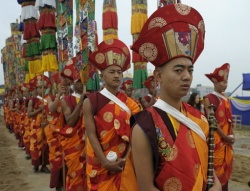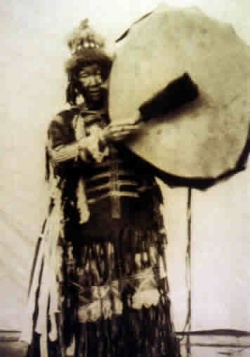Monastic Pedagogy in Tibetan Buddhism 15-18c
A review of Monastic Pedagogy on Emptiness in the Geluk Sect of Tibetan Buddhism: Intellectual History and Analysis of Topics Concerning Ignorance According to Svātantrika-Mādhyamika in Monastic Textbooks by Jamyang Shaypa, by Jongbok Yi.
This study presents a comprehensive analysis of monastic literature known as Decisive Analysis (mtha’ dpyod) and approaches this genre of Tibetan Buddhist scholastic writings from a historical, intellectual, and didactic viewpoint. The main focus of the thesis is on the section concerned with the “object of negation” and its significance as part of the monastic curriculum of Gomang Monastic College of Drepung Monastery in Lhasa, Central Tibet.
The primary source material used for this study is a textbook critically redacted by Jamyang Shaypa (’Jam dbyangs bzhad pa’i rdo rje, 1648-1721/22); the thesis specifically examines one of this figure’s most famous works—Decisive Analysis of the Middle (Dbu ma’i mtha’ dpyod), also known as Great Exposition of the Middle (Dbu ma chen mo)—which became the standard manual for the study of Madhyamaka philosophy in this particular monastery. Jamyang Shaypa was an important scholar of Gomang College and was renowned as the author of this institution’s scholastic manuals, which replaced an earlier syllabus written by Gungru Chökyi Jungné.
Jongbok Yi uses the aforementioned text as his main source for the reconstruction of the history of monastic textbooks in Gomang Monastic College, as these types of textbooks were an important part of the curriculum for academic study and debate within Geluk monasteries.
He also makes a salient point by showing that both inter- and intra-sectarian controversies recorded in these manuals provide valuable insight into the formation of Buddhist doctrine in the large-scale Geluk monasteries which dominated Central Tibet from the seventeenth century onwards.
The swift development of a large network of state-sponsored monasteries appears to have impelled monastic textbook production and thus these primers offer crucial information on the history of philosophy in Tibet, as well as the way in which Tibetan Buddhist monastic scholars understood, analyzed, and revised intellectual/philosophical stances both inside and outside of their own tradition.
Yi points out that Tibetan Buddhist monastic textbooks outlining practical and philosophical skills that student monks apply in the debating courtyard have been studied to some extent, notably in the “Philosophical Literature” section of Tibetan Literature: Studies in Genre (José Ignacio Cabezón and Roger R. Jackson eds., Tibetan Literature: Studies in Genre. Ithaca: Snow Lion Publications, 1996, pp. 170-228).
Scholars such as Jeffrey Hopkins, Shunzō Onoda, Guy Newland, and Donald S. Lopez, Jr. all introduce different sections or chapters of monastic textbooks such as Doxography (grub mtha’), Collected Topics (bsdus grwa), and so forth.
However, Yi’s current study provides a much more exhaustive approach to this genre. In Part I, he outlines the transition of monastic textbooks from “old” to “new” systems in Gomang College and provides historical context for monastic education, from the fifteenth century and the transition from Gungru Chökyi Jungné’s Old Monastic Textbooks to Jamyang Shaypa’s innovations in the eighteenth century.
Yi presents the development of monastic textbooks in Drepung’s Gomang Monastic College from the fifteenth to eighteenth centuries in three stages:
He explains that the initial monastic textbooks of Gomang Monastic College were relatively late creations compared to other Geluk monastic colleges.
The establishment of these early monastic textbooks is interesting due to the fact that the oral teachings of Gungru Chökyi Jungné were dictated and adopted as textbooks, and that this coincided with great political and spiritual upheaval in Central Tibet.
Subsequently, these older works were supplanted by the works of Jamyang Shaypa, who essentially performed a critical overhaul of Gungru Chökyi Jungné’s system by composing and installing his own monastic textbooks in a critical dialog with the older system. This dissertation then examines how Decisive Analysis functions not just as an authoritative monastic text explicating debate skills and strategy, but also can be used to trace the College’s academic development and history.
Yi also argues that the monastic textbooks themselves symbolically contributed to the identity of Gomang College. In Chapters 2 to 4 of this dissertation, the author examines the intellectual history of the genre of Decisive Analysis based on the section on “the object of negation” in Madhyamaka philosophy in Jamyang Shaypa’s Decisive Analysis.
Chapter 2 is concerned with Tsongkhapa’s (un)intentional misinterpretation of the Indian source text, Illumination of the Middle by Kamalaśīla. In Chapters 3 and 4, Yi shows that the content of a series of debates in the “Refuting Other Systems” and “Dispelling Objections” sections holds refutations of different explanations and concludes that Decisive Analysis—along with other monastic textbooks—is not merely designed for the sake of the student monks’ debating skills, but is also a didactic device intended to transmit the lively intellectual history of Gomang Monastic College as well as the Geluk school as a whole. Chapter 5 aims to clarify the condensed meaning of the “three spheres (of self-contradiction)”(’khor gsum) and demonstrate the relevance of this distinctive debate concept.
The second half of the thesis further examines the pedagogical facets of Decisive Analysis with a tabular presentation demonstrating how the monastic textbooks have an explicit instructive goal and function: they teach monks how to debate but also present arguments promoting specific philosophical points. Unlike other genres of monastic textbooks, Decisive Analysis mostly consists of debates save for the section on “Establishing Our Own System.”
The tabular presentation contained in Part II of this dissertation charts Jamyang Shaypa’s own positions taken from a series of debates documented in the “Refuting Other Systems” and “Dispelling Objections” sections. Via this columnar presentation of Jamyang Shaypa’s philosophical points in debate format, Yi argues that debate is an important pedagogical tool fulfilling two goals:
“sharpening one’s reasoning through directly learning debate strategies and enriching Jamyang Shaypa’s philosophical system by indirectly teaching the opposite of Jamyang Shaypa’s criticism” (p. 342).
This thesis presents a detailed and comprehensive contribution to the understanding of the pedagogical facets as well as the intellectual and social history of monastic textbooks in Gomang Monastic College. The author concludes by stating his intention to expand the scope of this research to further examine the early history of this monastic college as well as the early history of Drepung Monastery.
Having limited the study to one section, the “object of negation” in ppSvātantrika-Mādhyamika[[, he proposes that a columnar presentation of other sections and chapters of ppJamyang Shaypa’s[[ Decisive Analysis would provide additional insight into the social, intellectual, and pedagogical history of Gomang Monastic College. As such, this would contribute greatly to the understanding of Tibetan Buddhist monastic curricula as a whole.
It would offer Tibetological and Buddhist Studies scholars a valuable resource, as well as provide crucial insights into the political, social, and intellectual history of Geluk monastic education during a momentous period in Tibetan history.
Dr. Amelia Hall (D.Phil. University of Oxford) Department of Religious Studies Central Michigan University



